-
Welcome to BirdForum, the internet's largest birding community with thousands of members from all over the world. The forums are dedicated to wild birds, birding, binoculars and equipment and all that goes with it.
Please register for an account to take part in the discussions in the forum, post your pictures in the gallery and more.
You are using an out of date browser. It may not display this or other websites correctly.
You should upgrade or use an alternative browser.
You should upgrade or use an alternative browser.
JTMB's Bird Art (1 Viewer)
- Thread starter JTMB
- Start date
More options
Who Replied?phil baber
Clipped Wing

Smart and colourful covert capture of a Coop's John!
Echoing the above...perfect rendition of an Accipiter's Death Stare...Lovely!
Echoing the above...perfect rendition of an Accipiter's Death Stare...Lovely!
JTMB
Well-known member
Thanks, Phil!
Here is a quick study (9 x 12 inches) in watercolor of two Black-crowned Night Herons along a slough that I saw and photographed several years ago. I will be doing a larger version of this.
Question for the forum folks here...how do you folks go about deciding the level of detail you use in the background in a 'bird-in-a-landscape' type of painting like this. Yes, I know it's up to me ultimately and we all have our preferences - but it would be very educational for me to know the thought process used by the more experienced folks here.
In the study here, I used wet-into-wet for all the vegetation and the water, so there really isn't any detail in the background. Since these birds were right up against the bank of the slough, logic would say that there would be almost as much detail in the vegetation as there is in the birds. On the other hand, the actual background is very chaotic and painting it too realistically could, I think, take away from the focus on the birds.
Any inputs would be greatly appreciated...!
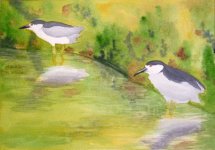
Here is a quick study (9 x 12 inches) in watercolor of two Black-crowned Night Herons along a slough that I saw and photographed several years ago. I will be doing a larger version of this.
Question for the forum folks here...how do you folks go about deciding the level of detail you use in the background in a 'bird-in-a-landscape' type of painting like this. Yes, I know it's up to me ultimately and we all have our preferences - but it would be very educational for me to know the thought process used by the more experienced folks here.
In the study here, I used wet-into-wet for all the vegetation and the water, so there really isn't any detail in the background. Since these birds were right up against the bank of the slough, logic would say that there would be almost as much detail in the vegetation as there is in the birds. On the other hand, the actual background is very chaotic and painting it too realistically could, I think, take away from the focus on the birds.
Any inputs would be greatly appreciated...!

JTMB
Well-known member
Varied Thrush Sketches
The Varied Thrush is one of the signature birds in our area - it is only found in the far west of the US, and so is a sought-after bird for easterners who visit our part of the country. This species is also noted for being shy and retiring, not easily found even though it is relatively common in the right habitat. In my yard, they are seen usually annually in migration, and off and on during the winter, when they come down from the high country to a less severe climate to winter over.
Usually, I see one or two in the yard a few times per month during the winter and that's about it. However, a couple days ago, we had a mammoth (by our standards) and very early snowstorm and deep freeze, and everybody started reporting a few more birds than usual. Well, in my yard, a few more translated to TEN of them today, and they hung around all day to feast on the seed that I spread every morning for the ground feeders. This provided an unusually good opportunity to sketch them - so I did. First, I spread some more seed right outside the kitchen nook window, and on the frozen birdbath that is only about two feet from the window. Several Varied Thrushes obliged by coming and feeding on the seed for what seemed like an eternity from a sketching viewpoint. I did two pages of pencil sketches to just get more comfortable with their structure and various angles...none of these was much to write home about, but it was good practice.
Then I did one sketch that I tried to make more detailed, and it came out well enough that I added watercolor washes to it after the sketch was done. Here are the results.
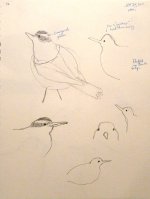
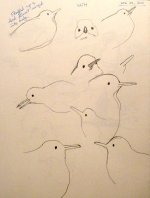
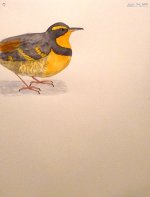
The Varied Thrush is one of the signature birds in our area - it is only found in the far west of the US, and so is a sought-after bird for easterners who visit our part of the country. This species is also noted for being shy and retiring, not easily found even though it is relatively common in the right habitat. In my yard, they are seen usually annually in migration, and off and on during the winter, when they come down from the high country to a less severe climate to winter over.
Usually, I see one or two in the yard a few times per month during the winter and that's about it. However, a couple days ago, we had a mammoth (by our standards) and very early snowstorm and deep freeze, and everybody started reporting a few more birds than usual. Well, in my yard, a few more translated to TEN of them today, and they hung around all day to feast on the seed that I spread every morning for the ground feeders. This provided an unusually good opportunity to sketch them - so I did. First, I spread some more seed right outside the kitchen nook window, and on the frozen birdbath that is only about two feet from the window. Several Varied Thrushes obliged by coming and feeding on the seed for what seemed like an eternity from a sketching viewpoint. I did two pages of pencil sketches to just get more comfortable with their structure and various angles...none of these was much to write home about, but it was good practice.
Then I did one sketch that I tried to make more detailed, and it came out well enough that I added watercolor washes to it after the sketch was done. Here are the results.



phil baber
Clipped Wing

John,
Remarkable insights into your World.
Those Varied Thrushes are absolute!
As to background? Your interpretation of it is important. But photos taken at the time may help as a reference later...
Useful and helpful.
It might become very "anal" sketching a bird then, sketching the background as well.
Is often done. But the day runs out of light, often, quite quickly!
It is a skill to capture both. Which is another subject for discussion here! (Tim Wootton's sketches capture BOTH admirably!...)
The study of landscape and plants thru photos can be very helpful. Especially at a later date and to broaden your knowledge.
Nice work!
Remarkable insights into your World.
Those Varied Thrushes are absolute!
As to background? Your interpretation of it is important. But photos taken at the time may help as a reference later...
Useful and helpful.
It might become very "anal" sketching a bird then, sketching the background as well.
Is often done. But the day runs out of light, often, quite quickly!
It is a skill to capture both. Which is another subject for discussion here! (Tim Wootton's sketches capture BOTH admirably!...)
The study of landscape and plants thru photos can be very helpful. Especially at a later date and to broaden your knowledge.
Nice work!
Last edited:
colleenc
Well-known member
wonderful sketches John, what a bird! I've never seen one, but then I don't have your depth of knowlege on birds and the small ones are mostly classed little brown job, little brown job with white, yellow etc, and even littler brown jobs.:-O
and no one around me is a birder so unless I can Id it in a book I'm stuck...except for some lovely people over on the id forum, who help if I can get a photo...which is not often...
and no one around me is a birder so unless I can Id it in a book I'm stuck...except for some lovely people over on the id forum, who help if I can get a photo...which is not often...
ARTHUR BISHOP
Well-known member
some lovely work John
RussB
Going for Gold
Cor, what a beastie Varied Thrush is! I've been lucky (and vigilant) enough to see quite a few of the more 'exotic' thrushes, especially out 'East' but this species would be right up with the best. I gather they're rather 'zoothera' like in habits, ie not very obliging, so you've done well making the most of the opportunity here.
I don't know about you John, but I would have had difficulty concentrating in such an event! Good work.
Russ
I don't know about you John, but I would have had difficulty concentrating in such an event! Good work.
Russ
JTMB
Well-known member
Thanks Phil, Colleen, Arthur, Gaby, Suvi and Russ!
Yes, these are very nice birds, and tough to find.
Colleen - you're probably pretty unlikely to see them in your area, which is in their winter range. There is a very small area of the country where they are found year-round (the 'wet side' of the mountains from very northern California up into BC and a bit of eastern WA, southern British Columbia and Alberta. They are forest birds, so in the wine country where you are, you would most likely have to be in a wooded area, or near one, to see them - although of course in migration like any species they can be found in some odd places with luck. Their summer range extends all the way up into Alaska.
Some of the birds are migratory, obviously, but in areas like our state where they are resident year-round, there are some that don't really migrate per se, but rather move down in elevation in the winter to milder conditions, then 'migrate' upslope again in the spring to their higher elevation breeding areas.
If you are lucky enough to see one, especially a male, it will be a thrill.
Interestingly, I got a good photo of one that visited our little recirculating stream in the yard a couple years ago, and submitted the image to Cornell's Lab of Ornithology since I participate in some of their survey programs. They went crazy over the photo since they don't get the birds back in New York, and it is on their website and has been used in at least one of their brochures as well.
Thanks again, everyone!
Yes, these are very nice birds, and tough to find.
Colleen - you're probably pretty unlikely to see them in your area, which is in their winter range. There is a very small area of the country where they are found year-round (the 'wet side' of the mountains from very northern California up into BC and a bit of eastern WA, southern British Columbia and Alberta. They are forest birds, so in the wine country where you are, you would most likely have to be in a wooded area, or near one, to see them - although of course in migration like any species they can be found in some odd places with luck. Their summer range extends all the way up into Alaska.
Some of the birds are migratory, obviously, but in areas like our state where they are resident year-round, there are some that don't really migrate per se, but rather move down in elevation in the winter to milder conditions, then 'migrate' upslope again in the spring to their higher elevation breeding areas.
If you are lucky enough to see one, especially a male, it will be a thrill.
Interestingly, I got a good photo of one that visited our little recirculating stream in the yard a couple years ago, and submitted the image to Cornell's Lab of Ornithology since I participate in some of their survey programs. They went crazy over the photo since they don't get the birds back in New York, and it is on their website and has been used in at least one of their brochures as well.
Thanks again, everyone!
solitaryVSong
Well-known member
A beautiful version of a beautiful bird! Long after the fact I heard that there was actually a Varied Thrush in Pennsylvania a couple of years ago. But due to fear about it being able to survive its location was largely kept a secret. I can't complain. But it sure would be nice to see.
solitaryVSong
Well-known member
But it sure would be nice to see.
Now if only I'd been 100 miles east in Central Park, NYC, yesterday:
http://10000birds.com/varied-thrush-in-central-park.htm
JTMB
Well-known member
Great Egrets - Oregon Coast
Thanks, Ken!
Wow - a Varied Thrush in NYC! I'll bet that brought throngs of birders into Central Park! The bird was a female based on the photo in the link you listed.
Here is a painting I did yesterday and today - about 3 hours total. It is 9 x 12 inches in watercolor, based on a photo I took two years ago at the mouth of the Salmon River on the Oregon coast, a bit north of Lincoln City. Great Egrets are not that common in Oregon and Washington, so it was nice to see them. It was early morning, calm and with the last remnants of fog lifting.
I'm not sure this is the composition I will be using on the larger paintings - which I intend to do in both oil and watercolor. There were actually about a dozen egrets in the flock when I took the images, but I simplified it down to three and modified the landscape a bit as well.
Suggestions are welcome, as always.
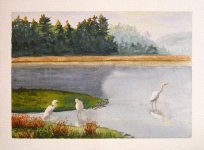
Thanks, Ken!
Wow - a Varied Thrush in NYC! I'll bet that brought throngs of birders into Central Park! The bird was a female based on the photo in the link you listed.
Here is a painting I did yesterday and today - about 3 hours total. It is 9 x 12 inches in watercolor, based on a photo I took two years ago at the mouth of the Salmon River on the Oregon coast, a bit north of Lincoln City. Great Egrets are not that common in Oregon and Washington, so it was nice to see them. It was early morning, calm and with the last remnants of fog lifting.
I'm not sure this is the composition I will be using on the larger paintings - which I intend to do in both oil and watercolor. There were actually about a dozen egrets in the flock when I took the images, but I simplified it down to three and modified the landscape a bit as well.
Suggestions are welcome, as always.

sfrissell
Well-known member
You've been busy, John. I think I can see progress in your drawing just between the first and second pages of juncoes! The body shapes in page two are excellent.
Since you are getting the hang of sketching body shapes, start looking more closely at bills and feet. You might look at birds in a bird book to see how feet and bills are constructed, then you will understand what you are seeing in the field. Your body shapes are too good to have only stick-figure legs. That said--feet and bills are not easy for me either and I've been watching birds for some 50 years. Some artists avoid feet with careful placement of leaves etc.!!
Ah, Varied Thrushes--I love them. I worked for the Forest Service in western Washington back in the 1960's. We had Varied Thrushes around all winter--they called them "Winter Robins." I really like their strange "song??" a series of drawn out single notes, each on a different pitch, sounding like they were singing in a rain barrel. We see Varied Thrushes here in Montana but not regularly, so keep supplying me with new sketches so I can enjoy them more.
Since you are getting the hang of sketching body shapes, start looking more closely at bills and feet. You might look at birds in a bird book to see how feet and bills are constructed, then you will understand what you are seeing in the field. Your body shapes are too good to have only stick-figure legs. That said--feet and bills are not easy for me either and I've been watching birds for some 50 years. Some artists avoid feet with careful placement of leaves etc.!!
Ah, Varied Thrushes--I love them. I worked for the Forest Service in western Washington back in the 1960's. We had Varied Thrushes around all winter--they called them "Winter Robins." I really like their strange "song??" a series of drawn out single notes, each on a different pitch, sounding like they were singing in a rain barrel. We see Varied Thrushes here in Montana but not regularly, so keep supplying me with new sketches so I can enjoy them more.
JTMB
Well-known member
Thanks, Sid! Yes, we're really lucky to have the Varied Thrushes around - they are great birds. I also love their 'song' - that raspy whistle. I've always wondered how they determine which pitch to start with and which pitch to go to after the first one.
We just had a cold snap and a 6-inch snowfall, with temps down to 5 degrees at our place for two nights. The word quickly spread and we wound up with TWELVE at one time in the yard at the height of the cold snap. Now that the snow is gone, the number has dwindled back down to 6, but at least we still have them daily at this point. Most years they're quite irregular.
As to feet...yes, I agree. Part of the issue I'm finding as I look through my photographs (and in talking with a couple other artists) as well as watching the birds in the yard...there are a lot of times where the feet (or at least the 'toes') are not visible. I'll have to watch more closely and dig out the ornithology books again. :-O
We just had a cold snap and a 6-inch snowfall, with temps down to 5 degrees at our place for two nights. The word quickly spread and we wound up with TWELVE at one time in the yard at the height of the cold snap. Now that the snow is gone, the number has dwindled back down to 6, but at least we still have them daily at this point. Most years they're quite irregular.
As to feet...yes, I agree. Part of the issue I'm finding as I look through my photographs (and in talking with a couple other artists) as well as watching the birds in the yard...there are a lot of times where the feet (or at least the 'toes') are not visible. I'll have to watch more closely and dig out the ornithology books again. :-O
solitaryVSong
Well-known member
Your paintings are really coming along John. The new one has a simplicity and stillness to it reminiscent of many a morning view I've had of egrets and herons. Also a nice sense of movement in the birds.
I'm well aware of the problems of feet and other such details. That's one of the things that drove me nuts when I started drawing and painting birds. I didn't want to use the photos of others and the few I had were often missing feet or other important details. Lots of additional photos helped. But most important was getting a scope and being able to see such things. I was concentrating on the feet of the recent Red-tail when all of a sudden he dived to our feet after his prey. But until then I'd been excited at having such a good look at his feet.
I'm well aware of the problems of feet and other such details. That's one of the things that drove me nuts when I started drawing and painting birds. I didn't want to use the photos of others and the few I had were often missing feet or other important details. Lots of additional photos helped. But most important was getting a scope and being able to see such things. I was concentrating on the feet of the recent Red-tail when all of a sudden he dived to our feet after his prey. But until then I'd been excited at having such a good look at his feet.
phil baber
Clipped Wing

John...
A BEAUTIFUL composition!
A BEAUTIFUL composition!
Similar threads
- Replies
- 8
- Views
- 769
Users who are viewing this thread
Total: 2 (members: 0, guests: 2)



